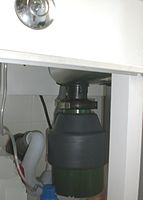
Photo from wikipedia
Objective: Investigation of the safety, tolerability, and treatment effect of nusinersen treatment in non-ambulatory adults with spinal muscular atrophy (SMA). Methods: Non-ambulatory individuals, aged 18 years or older with genetically… Click to show full abstract
Objective: Investigation of the safety, tolerability, and treatment effect of nusinersen treatment in non-ambulatory adults with spinal muscular atrophy (SMA). Methods: Non-ambulatory individuals, aged 18 years or older with genetically confirmed 5q SMA were enrolled. In participants with spinal fusion, fluoroscopy guided cervical C1–C2 lateral approach was used. Outcomes at 2, 6, 10, and 14 months post-treatment were compared with baseline assessment. Forced vital capacity (FVC) was the primary outcome, and RULM, HFMSE, the modified SMA-FRS, and ulnar nerve electrophysiology [compound muscle action potential (CMAP), single motor unit size, and motor unit number] were secondary. Adverse and serious adverse events and clinically significant vital sign or lab abnormalities were recorded. Results: Results from 12 women and 7 men (mean age: 39.7 ± 13.9, range: 21–64 years) were analyzed. No clinically significant changes of vital signs or laboratory parameters were observed. Five participants were hospitalized for pneumonia. Other adverse events included headache, back pain, cervical injection site pain, and upper respiratory and urinary tract infections. High baseline protein/creatinine ratio without significant change on treatment noted in 4 participants. FVC was feasible in all participants. HFMSE and RULM were not feasible in the majority of participants. FVC and functional outcomes were stable without improvement. CMAP and single motor unit potential sizes showed enlargement while motor unit numbers were stable. Conclusions: Nusinersen, including C1/C2 delivery, was safe overall and well-tolerated. Several outcome measures were limited by floor effect. Overall, treatment resulted in stability of motor outcomes, but motor unit and CMAP size were increased.
Journal Title: Frontiers in Neurology
Year Published: 2021
Link to full text (if available)
Share on Social Media: Sign Up to like & get
recommendations!